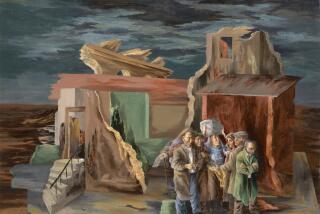Grace notes of an Italian bard
When Cesare Pavese started publishing in the early 1930s, Italian fascism was at its height. Everything about fascism, not least of all its nationalism, was repugnant to Pavese, who was arrested for subversive activities and sent for three years to a remote town in southern Italy. During his time in the south, which was commuted to eight months, Pavese finished his first book: his sequence of narrative poems, “Lavorare stanca” (literally “working tired,” but translated for “Disaffections” as “Work’s Tiring”), one of the most singular collections of Italian poetry in the 20th century. Pavese went on to become a celebrated novelist, writing relatively little poetry between 1940 and 1950, when he committed suicide at the age of 42.
Until now, Pavese’s poetry hasn’t been available in an English translation that carries both the colloquialness of his language and the haunting rhythms of his verse. Geoffrey Brock’s fine new translation has met this need so that, combined with the recent reissue of several of Pavese’s novels, American readers can have the pleasure of getting to know him in some depth.
As Brock points out in the introduction to this book, Pavese’s style couldn’t have been more different from the prevailing trends in Italian poetry of the 1930s. The very year of “Lavorare’s” first edition, 1936, was when the term “hermetic” was first used to describe the verse of the leading poets of that time: Giuseppe Ungaretti, Eugenio Montale and others. This style, derived from the French Symbolists, was introspective, elliptical and very dense; it usually left out the social dimension and the contingencies of everyday life (as lyrical poetry in general often has). But Pavese in the 1930s wanted to write like this:
We’re walking one evening on the flank of a hill
in silence. In the shadows of dusk
my cousin’s a giant dressed all in white,
moving serenely, face bronzed by the sun.
We notice one thing right away, besides the vividly observed detail and the cadences so beautifully rendered by Brock: We are being told a story. Storytelling is not something poets did very often in the 20th century. In order to tell his “poem-stories,” as he called them, Pavese followed a standard Modernist strategy: Unable to find honest emotional expression in received forms, he had to improvise. In the introduction, Brock quotes Pavese’s charming account of how he discovered the meter he would use for “Lavorare”: “One day I found myself muttering a certain jumble of words ... in a pronounced cadence that I had used for emphasis ever since I was a child, when I would murmur over and over the phrases that obsessed me most in the novels I was reading. That’s how, without knowing it, I found my verse.” Pavese called the meter “the rhythm of my daydreaming.” It has an effect that in Italian has been called cantilenante, singsong:
All things seem possible in the gloom of the tavern.
The sky outside could be brilliant with stars,
beyond autumn’s fog and the scent of pressed grapes.
Even now, the ragged songs of the harvesters
could be rising from the emptied fields on the hill.
It is a rhythm that verges on monotony and puts a kind of spell on the listener, running like a bass line through the poems, hinting at darker, more hidden meanings than the ones that are so accessible on the surface. Most important for the present book is that Brock does so well in bringing across this effect in English. Brock rightly points out that the earlier 1976 American translation of “Lavorare,” by distinguished translator and scholar William Arrowsmith, was “chattier and less measured (in all senses of that word) than Pavese’s original poems, whose tight-lipped rhythm becomes an integral part of the experience of reading them.”
Pavese uses the 77 vignettes of “Lavorare,” almost all of them a page long or a little more, to look closely, unflinchingly, at fundamental human experiences: love, sex (it’s quite erotic at times), hunger, family, aging, youth, the passion for passion itself (a lot of drunks and people getting drunk) and, not least, boredom or ennui:
Is it worth the trouble for the sun to rise up
from the sea and begin the long day? Tomorrow
the warm dawn will return with its diaphanous light
and, just like yesterday, nothing will happen.
Pavese, who was intensely interested in mythology, had in mind a theme very close to that of the Greek tragedists: the antiquity or timelessless of passion, man’s place in nature and the human community, and the sadness or ennui that springs from longing’s inevitable unfulfillment. Like the characters in Greek tragedy, the people in these stories -- laborers, pregnant women, old lonely drunks, sexually frustrated young men and many others -- are as if trapped in their lives, in the situations in which they find themselves, crazy desires fully intact. There is an eerie detachment in Pavese’s observations -- or perhaps aloofness is a better word. He is strangely aloof and intimate at the same time.
Pavese was born in a rural town near industrial, cosmopolitan Turin and grew up in the city, spending many childhood summers back in his native town. The tension Pavese felt within himself between city and country is central to these poems: “Pavese’s early poems,” Brock explains, “are inhabited by characters who seem to have been drawn to the city by its economic promise, only to encounter varying degrees of disappointment and isolation.” Masino, for example, in “Idleness”: “Whenever he eats, Masino returns to his search, / since it means he’s finished a job. He walks down the street / no longer looking at anyone’s face.” Or Gella, “who works in the city but returns each evening to the family farm”: “Gella’s fed up with going and coming, traveling at night, / living neither among buildings nor out in the vineyards. / She wishes the city were up on those hills, / luminous, secret: never again would she leave it.”
“Lavorare stanca,” which takes up the first two sections of “Disaffections,” is Pavese’s most distinctive poetic achievement. The third section is composed of poems that Pavese wrote in the same period, 1930 to 1940, but that weren’t collected in his lifetime. Several of the poems in this group of 30 are more introspective, not as specifically located as the poems in “Lavorare,” as though characters from the narrative poems had sat down to write their own thoughts in verse. Arrowsmith didn’t include these poems, and they are a welcome addition to the body of Pavese in English.
The final section of the book contains the lyrical poems Pavese wrote in the last five years of his life. It is interesting to note that Pavese’s lyrical style resembles the 20th century high poetic style he had rejected in the narrative poems. Most of these poems -- 21 in all -- are love poems. Pavese often suggests a near identity between the forces of nature and a woman’s body: “The gray light of your eyes -- / sweet drops of dawn / on the dark hills.”
Brock’s translations are faithful to Pavese’s tone, even as they usually stay close to the literal meaning. Brock’s alterations of the original literal meaning are often sensitive and slight -- only a minor tweaking of meaning for the sake of the poetry. There are some places where such alterations weren’t quite accurate enough. “Crazy old bum” for un povero folle, for instance, adds a jokey tone that isn’t there in the Italian, which literally is “a poor fool.” Or, in “Deola Thinking,” a poem about a prostitute, Deola’s bedcover is “black with the boot-prints of soldiers and workers” when the original literally says the cover is made dirty by “the foul shoes of soldiers and workers,” which seems quite a different image. A poem about a man wandering the streets lonely for a woman ends with an imaginary woman “lead[ing] him home by the hand,” a literal translation of dar mano alla casa, which in everyday idiom means “lending a hand at home.” Here Pavese’s actual closing image is characteristically unsentimental, unlike the translation’s. Or in another poem depicting the relationship between a rough father and son, “Si direbbe che mangiano / l’uno le ossa dell’altro” literally means, “You might say that they eat each other’s bones.” Pavese’s final manuscript (according to a note in the original edition) had succhiano, “they suck each other’s bones,” clearly indicating that this relationship is not healthy. Brock’s “You might say / [the son] didn’t fall far from the tree” misses this sense of the original. These are the sorts of minor lapses in interpretation in an otherwise impressive achievement. *
More to Read
Sign up for our Book Club newsletter
Get the latest news, events and more from the Los Angeles Times Book Club, and help us get L.A. reading and talking.
You may occasionally receive promotional content from the Los Angeles Times.







